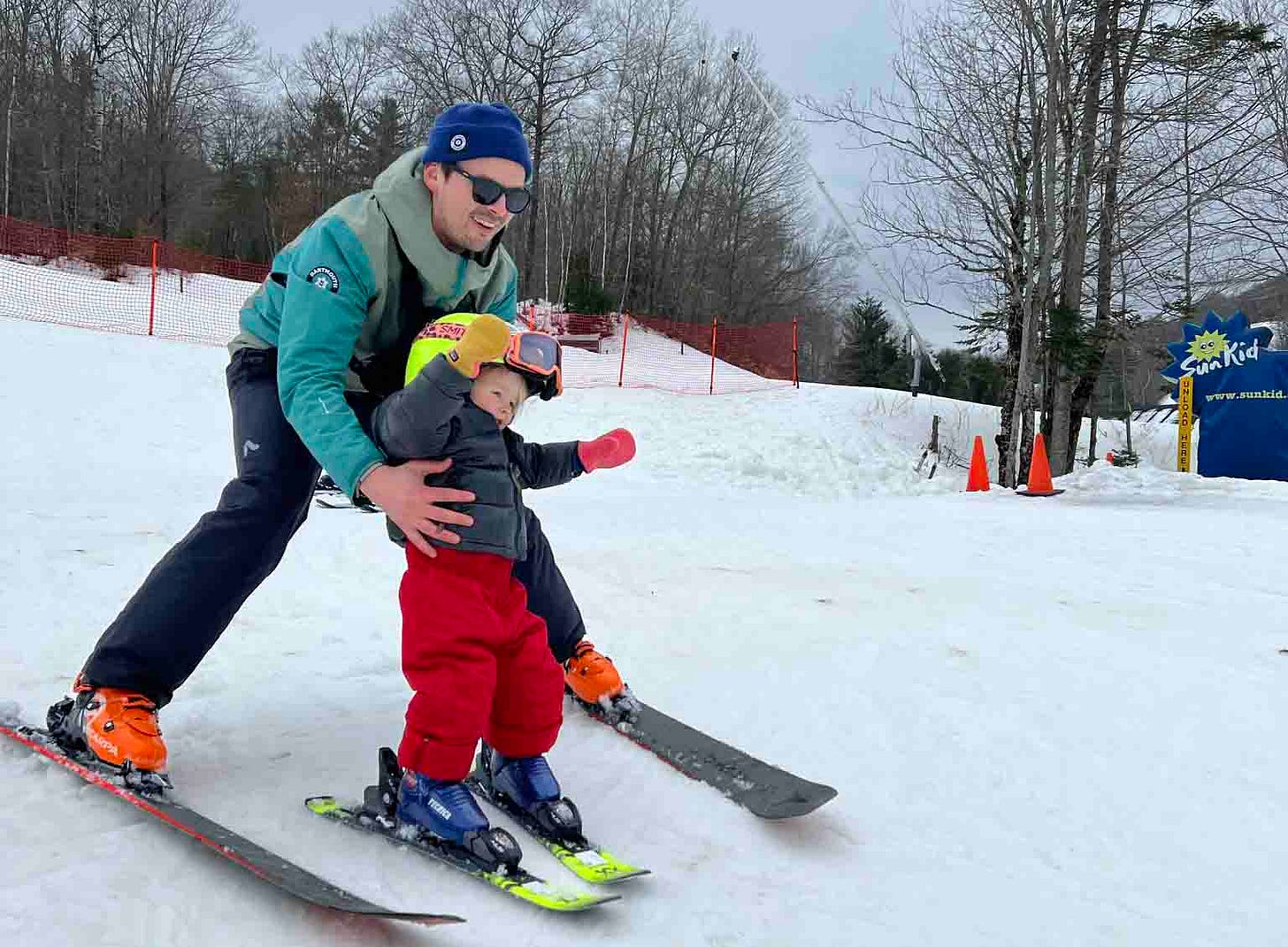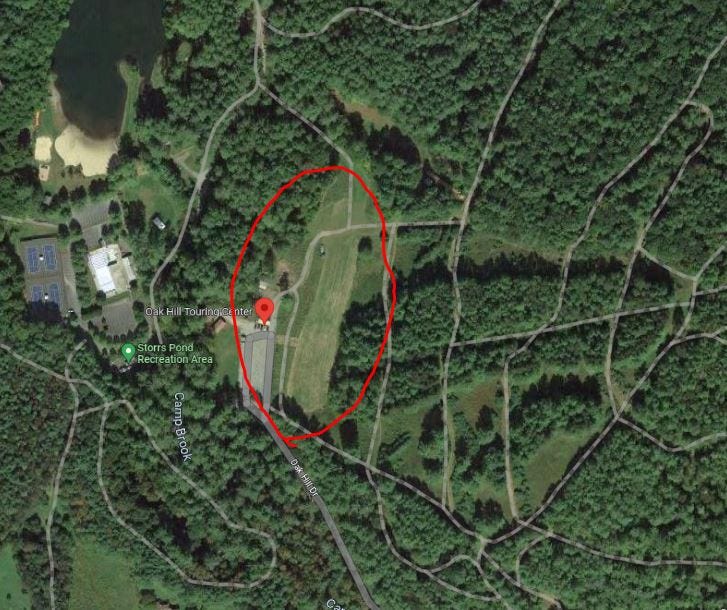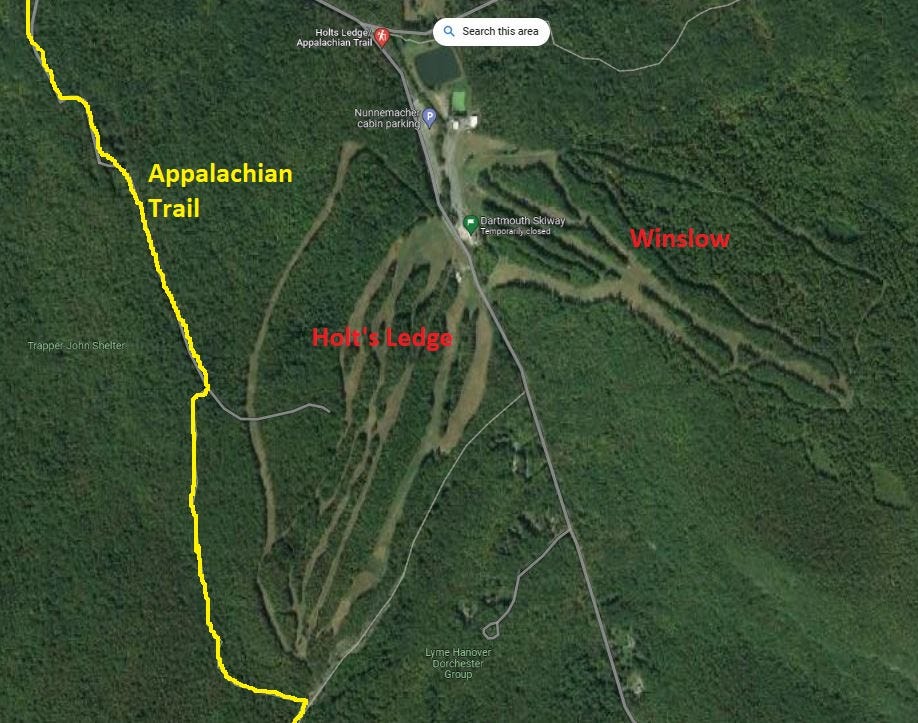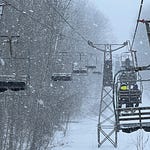Who
Mark Adamczyk, General Manager of Dartmouth Skiway, New Hampshire
Recorded on
June 12, 2023
About Dartmouth Skiway
Click here for a mountain stats overview
Owned by: Dartmouth College
Located in: Lyme Center, New Hampshire
Year founded: 1956
Pass affiliations:
No Boundaries Pass: between 1 and 3 days, depending upon when the pass is redeemed
Indy Pass Allied Resorts: Indy Pass holders get 50 percent off weekday lift tickets and 25 percent off weekends and holidays
Reciprocal partners: None
Closest neighboring ski areas: Storrs Hill (33 minutes), Whaleback (36 minutes), Northeast Slopes (36 minutes), Harrington Hill (41 minutes), Quechee (42 minutes), Ragged (48 minutes), Tenney (53 minutes), Saskadena Six (54 minutes), Ascutney (55 minutes), Arrowhead (59 minutes), Mount Sunapee (59 minutes), Veterans Memorial (1 hours, 6 minutes), Campton (1 hour, 6 minutes), Kanc (1 hour, 10 minutes), Loon (1 hour, 11 minutes), Waterville Valley (1 hour, 17 minutes), Cannon (1 hour, 17 minutes), Killington (1 hour, 20 minutes), Pico (1 hour, 21 minutes), Okemo (1 hour, 22 minutes)
Base elevation: 968 feet
Summit elevation: 1,943 feet
Vertical drop: 968 feet
Skiable Acres: 104
Average annual snowfall: 100 inches
Trail count: 28 (25% advanced/expert, 50% intermediate, 25% beginner)
Lift count: 4 (1 fixed-grip quad, 1 double, 2 carpets – view Lift Blog’s inventory of Dartmouth Skiway’s lift fleet)
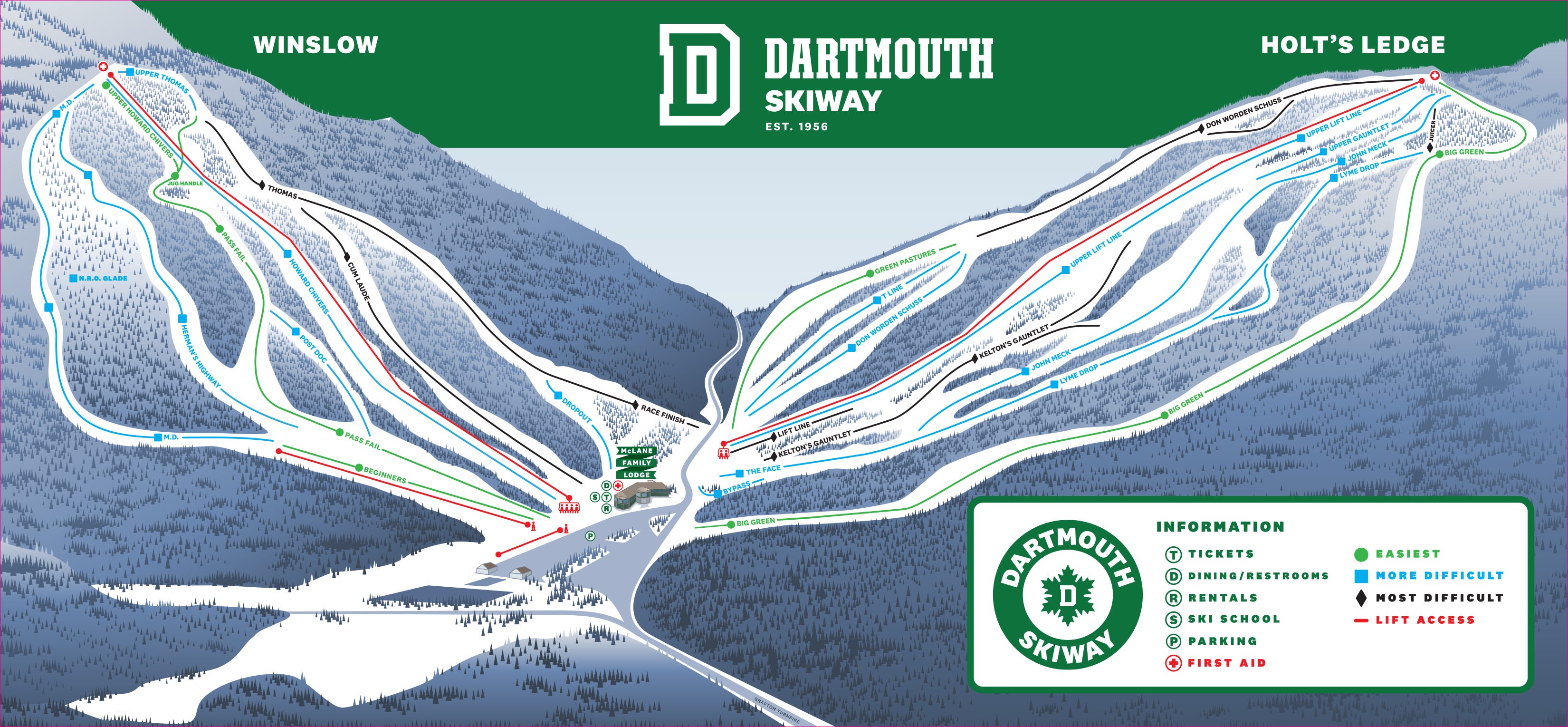
Why I interviewed him
Isn’t it interesting what exists? Imagine if Yale or Dartmouth or hell the University of Vermont wanted to build a ski area today. They’d have better luck genetically splicing a goat with an Easter egg. Or building a Chuck E. Cheese on Jupiter. Or sealing the Mariana Trench with toothpaste. Imagine the rage from alumni, from the Leaf Defenders, from whatever town they decided to slice the forest up over. U.S. American colleges collectively acting as the NFL’s minor league while piling up millions in broadcast and ticket revenue – totally fine. A college owning a ski area? What are you, insane?
But here we are: Dartmouth College owns a ski area. The origin story, in my imagination: Eustacious VonTrappenSquire VIII, president of Dartmouth and also Scout Emeritus of his local outing club, orders his carriage driver to transport him up to Lyme, where he intends to stock up on parchment and whale oil. As he waits for the apothecary to mix his liver tonic, the old chum takes a draw from his pipe and, peering through his spectacle, spies Holt’s Ledge and Winslow Ledge rising more than 2,100 feet off the valley floor. “Charles, good fellow, the next time you draw up the horses, be a swell and throw my old snowskis into the carriage. I fancy a good ski on those two attractive peaks yonder.” He then loads his musket and shoots a passenger pigeon mid-flight.
“But Sir,” Charles replies, “I’m afraid there’s no trails cut for snow-skiing on those peaks.”
“Well by gum we’ll see about that!” the esteemed president shouts, startling one of the horses so badly that it bolts into Ms. McHenry’s salon and knocks over her spittoon. VonTrappenSquire, humiliated, repays her by making McHenry Dartmouth Skiway’s first general manager.
Unfortunately for my imagination, the actual story is provided in Skiway: A Dartmouth Winter Tale by Everett Wood (sourced from the Skiway’s website):
With its northern New England location and an active Outing Club, Dartmouth College was “the collegiate champion of the outdoor life and winter sports” in the early 1900s. A number of men skied for the United States in the 1936 Winter Olympics in Germany, an amazing feat given that their local ski hills were what is today the Hanover Country Club.
In April 1955, a report, spearheaded by John Meck ’33 entitled, “Development of Adequate Skiing Facilities for Dartmouth Students in the Hanover Area,” was submitted to the Dartmouth Trustee Planning Committee. The report outlined five basic principles, the first two stating, “Dartmouth has had a preeminence in skiing which has been beneficial and… it is very desirable that this preeminence be maintained… both in terms of competition at the ski team level and of recreational skiing for the student body generally.” The Trustees were sold with the idea.
New England Ski History provides the rest:
Following John Meck's report … Dartmouth developed trails on the northeastern slope of Holt's Ledge for the 1956-57 season. Climbing up the new 968 vertical foot complex was a 3,775 foot Poma lift, which reportedly served 5 trails. At the foot of the area, the Peter Brundage Lodge was constructed, designed by local architect W. Brooke Fleck. Dartmouth College formally dedicated its new Holt's Ledge ski area on January 12, 1957, while the lodge was inaugurated on March 3. Accomplished racer Howard Chivers, class of 1939, was the area's first manager.
So there you go: Dartmouth College owns a ski area. But what has kept the college from filing the Skiway in the basement alongside the Latin curriculum and phrenology textbooks? Why does the 12th best university in America, according to U.S. News & World Reports’ rankings, own the 42nd largest ski area in New England by vertical drop? How does Dartmouth Skiway enrich the culture and mission of Dartmouth College in 2023? And where does this peculiar two-sided ski area fit into a New England ski scene increasingly dominated by out-of-state operators with their megapasses and their 42-passenger steamship lifts and their AI-generated, 3D-printed moguls? I had to find out.

What we talked about
Breaking down the 2022-23 ski season; blowing snow on Holt’s earlier in the season; staying competitive in a New England dripping with Epic and Ikon Passes; turning skiing into bowling; staying mentally strong through weeks-long stretches of crummy weather; the Indy Allied Resorts program and whether Dartmouth Skiway would join the Indy Pass; the No Boundaries ski pass; Victor Constant; Winter Park and the impact of the Ikon Pass; the angst of taking over a ski area in spring 2020; why Dartmouth College owns a ski area; it’s a public ski area, Folks; Olympic legacy; Dartmouth College 101; students on Patrol; the financial relationship between the college and the ski area; Friends of the Skiway; Dartmouth’s unusual two-face layout; whether the two sides could be connected via tunnel or other means; why both sides of the Skiway stop more than 1,000 vertical feet short of their mountain summits, and whether that could ever change; expansion opportunities; a student-led environmental assessment of the Skiway; “we have great potential to be one of the most sustainable ski areas in the country”; upgrading snowmaking; the Dupree family and HKD’s support of the ski area; upgrading the Holt’s Ledge double; where we could see a non-beginner surface lift; whether we could ever see a high-speed lift on either side of the mountain; building out the glade network; the potential for night-skiing; and season passes.
Why I thought that now was a good time for this interview
Adamczyk is relatively new to Dartmouth Skiway, arriving that first Covid summer with a Winter Park employee pass still dangling from his ski jacket. It was a scary time to punch in for your first ski area general manager role, but also an opportune one: suddenly, none of the old ways worked anymore. Rethink everything. Try anything. It was a moment of maximum creativity and flexibility in a sometimes-staid industry.
Not that Adamczyk has done anything radical. Or needed to – Dartmouth Skiway, unlike so many small New England ski areas living and dead, is well-financed and well-cared-for. But his timing was exquisite. Covid reshuffled the purpose and place of small-mountain skiing in the lift-served food chain. If Loon and Cannon and Sunapee and Waterville and Killington sold out or ran out of parking spots and you still needed someplace to ski that weekend, well, you may have ended up at Dartmouth Skiway.
The Skiway has been able to ride that momentum to steady increases in annual skier visits. What led directly to this podcast conversation was the Skiway’s first annual report, which Adamczyk assembled last November:
Adamczyk also helped found a Friends of Dartmouth Skiway group, a popular mechanism for supporting nonprofit organizations. You can contribute here:
Yes, the lifts are still slow, and they’re likely to stay that way. Dartmouth Skiway isn’t going to become Loon West, despite the thousand feet of unused vert hanging out on either side of the ski area. But the place holds a different sort of potential. Dartmouth Skiway can transform itself into a model of: a sustainable, energy-efficient ski area; a small mountain thriving in big-mountain country; and a nonprofit operating in a profit-driven industry. They’re off to a good start.
What I got wrong
Adamczyk and I briefly discussed when the Skiway updated the drive on its Holt’s Ledge Hall double. According to New England Ski History, the ski area upgraded the machine with a Doppelmayr-CTEC drive in 2005.
I had a squint-at-the-screen moment when I mis-guessed the name of the Winslow-side glade trail several times, calling it “M.R.O.,” “H.R.O.,” and “N.R.O.” It is N.R.O., as you can see (I do not know what “N.R.O.” stands for):
Why you should ski Dartmouth Skiway
It you’re looking for a peak-days getaway from the chaos of Killington or Cannon or Bretton Woods, this isn’t a bad alternative. Dartmouth Skiway’s 38,000 annual skier visits wouldn’t fill the K-1 gondola queue on a February Saturday. Sure, the Skiway’s lifts are slow and stop far below the summits, but the place is cheap and well-maintained, and it delivers a thousand(-ish) feet of vert, two distinct faces, and twisty-fun New England rollers.
But there’s something else. Over the past decade, I’ve shifted my ski season philosophy to emphasize exploration and novelty. I’ve always been a resort-hopper; my typical mid-90s ski season rotated through a dozen Michigan bumps punctuated by a run east or west. But by the time I’d moved east in the early 2000s, I held a firm prejudice for larger mountains, sculpting a wintertime rotation of Killington-Mount Snow-Stratton-Sugarbush-Gore-Whiteface (and the like), peppered with some Hunter Mountain or Windham. I’d convinced myself that the smaller ski areas weren’t “worth” my time and resources.
But then my daughter, now 15, started skiing. I hauled her to Gore, Sugarbush, Killington, Sunday River, Loon, Steamboat, Copper. Her preference, from the start, was for the smaller and less frantic: Thunder Ridge, Bousquet, Plattekill, Catamount, Royal, Willard, Mohawk, and her favorite, 200-vertical-foot Maple Ski Ridge outside Schenectady, New York. She’s at ease in these places, free to ski without mob-dodging, without waiting in liftlines, without fighting for a cafeteria seat.
And on these down-day adventures, I realized something: I was having a great time. The brutal energy of The Beast is thrilling and invigorating, but also exhausting. And so I began exploring: Elk Mountain, Montage, Greek Peak, Song, Labrador, Peek’N Peak, Oak Mountain, Mount Pleasant, Magic, Berkshire East, Butternut, Otis Ridge, Spring Mountain, Burke, Magic, King Pine, Granite Gorge, Tenney, Whaleback, Black Mountain of Maine. And so many more, 139 ski areas since downloading the Slopes app on my Pet Rectangle at the beginning of the 2018-19 ski season. This process of voyaging and discovery has been thrilling and gratifying, and acted as a huge inspiration for and catalyst of the newsletter you’re reading today.
I’ve become a completist. I want to ski every ski area in North America. Each delivers its own thrill, clutches its own secrets, releases its own vibe. This novelty is addictive. Like trying new restaurants or collecting passport stamps. Yes, I have my familiars – Mountain Creek, everything in the Catskills – where I can rip off groomers and max out the floaters and have calibrated the approach speed on each little kicker. But the majority of my winter is spent exploring the Dartmouth Skiways of the world.
Budget megapasses, with their ever-expansive rosters, have made it easier than ever to set up and cross off a wintertime checklist of new destinations. So take that Indy Pass, and, yes, cash in your days at Jay and Waterville and Cannon and Saddleback. But linger in between, at Black New Hampshire and Black Maine and Saskadena Six and Pats Peak. And cash in those discount days for the Indy Allied resorts: McIntyre and Whaleback and Middlebury Snowbowl and King Pine. And Dartmouth Skiway.

Podcast Notes
On the No Boundaries Pass
Dartmouth Skiway was an inaugural member of the No Boundaries Pass, a coupon book that granted access to four New England ski areas for $99 last season:
The pass was good for up to three days at each ski area. The concept was novel: No Boundaries mailed each passholder a coupon book that contained three coupons for each partner mountain. Skiers would then trade in one coupon for a non-holiday weekday lift ticket, two coupons for a Sunday lift ticket, and all three coupons for a Saturday or holiday lift ticket. So you could clock between four and 12 days, depending on when you skied. The pass delivers a payout to each ski area for each skier visit, just like Indy or Ikon or Mountain Collective.
The Indy Pass, of course, has already scooped up most of New England’s grandest independent mountains, and they don’t allow their mountains to join competing, revenue-generating passes. Dartmouth Skiway and Whaleback are both Indy Allied members, and it’s unclear how long Indy will tolerate this upstart pass. So far, they’re ignoring it, which, given the limited market for a small-mountain pass in a region rippling with deep megapass rosters, is probably the correct move.
On Victor Constant ski area
Adamczyk’s first job in skiing was at Victor Constant, a 475-vertical-foot ski area run by the U.S. Army at West Point, New York. It is one of the closest ski areas to New York City and is priced like it’s 1972, but almost no one has heard of the place. I wrote a brief recap after I stopped in two years ago:
Victor Constant pops off the banks of the Hudson, 500 vertical feet of pure fall line served by an antique yellow triple chair. It’s 45 miles north of the George Washington Bridge and no one knows it’s there. It’s part of West Point and managed by the Army but it’s open to the public and lift tickets are $27. The terrain is serviceable but the few inches of fresh snow had been paved into blacktop by inept grooming, and so I lapped the wild lumpy natural-snow trails through the trees for two hours. This tiny kingdom was guarded by the most amazing ski patroller I’d ever seen, an absolute zipper bombing tight lines all over the mountain and I could almost see the cartoon bubble popping out of his brain saying Goddamn I can’t believe I’m getting paid to crush it like this.
Here’s the trailmap:
If you live anywhere near this joint, do yourself a favor and swing through next winter.
On the Dartmouth Outing Club
We briefly discuss the Dartmouth Outing Club, which bills itself as “the oldest and largest collegiate outing club in the country. Anyone — member or not — may stay at our cabins, go on our trips, rent our gear, and take our classes.” Founded in 1909, the club, among other things, maintains more than 50 miles of the Appalachian Trail. Learn more here.
On the original Dartmouth ski area at Oak Hill
I couldn’t find any trailmaps of Dartmouth’s original ski hill, which Adamczyk and New England Ski History agree was a surface-lift bump at Oak Hill in Hanover. The area continues to operate as a Nordic center. My best guess is that the surface lift served the cleared area still visible on Google Maps:
If you have any additional insight here, please let me know.
On Dartmouth Skiway in letters and moving pictures
Dartmouth Skiway is the subject of at least two books and a PBS documentary:
Skiway: A Dartmouth Winter Tale, book by Everett Wood – order here
Passion for Skiing, book by Stephen L. Waterhouse – for some reason, this is priced at $489.89 on Amazon
Passion for Snow, PBS documentary based upon the Passion for Skiing book:
On Dartmouth’s two sides
Dartmouth Skiway is, like many ski areas, segmented by a road. But unlike Belleayre, which has addressed the issue with a bridge, or Titus, which has bored a tunnel underneath the highway, the Skiway hasn’t gotten around to creating a ski-across connection. You can skate across, of course, when the road has sufficient snow, but mostly you have to remove your skis and trek.
Holt’s Ledge opened first, with a 3,775-foot Poma in 1956 or ‘57, according to New England Ski History. Winslow followed in 1967, when the ski area opted to expand rather than install snowmaking. Grim winters followed – the Skiway operated just 34 days over the 1973-74 season and just four days in the 1979-80 campaign – before the mountain installed snowmaking in 1985.
On the Appalachian trail crossing over Holt’s Ledge
Dartmouth Skiway has compelling expansion potential. While the lifts rise just shy of 1,000 vertical feet on either side of the ski area, Holt’s Ledge holds 2,220 feet of total vertical, and Winslow soars 2,282 feet. Maximizing this on either side would instantly thrust the Skiway into the Cannon/Loon/Wildcat league of big-time New Hampshire ski areas. Adamczyk and I discuss vertical expansion potential on either face. There is some, it turns out, on Winslow. But Holt’s Ledge runs into the Appalachian Trail shortly above the top of the double chair. Meaning you have a better chance of converting the baselodge into a Burger King than you do of pushing the lift any higher than it goes today:
The Storm publishes year-round, and guarantees 100 articles per year. This is article 58/100 in 2023, and number 444 since launching on Oct. 13, 2019. Want to send feedback? Reply to this email and I will answer (unless you sound insane, or, more likely, I just get busy). You can also email skiing@substack.com.



